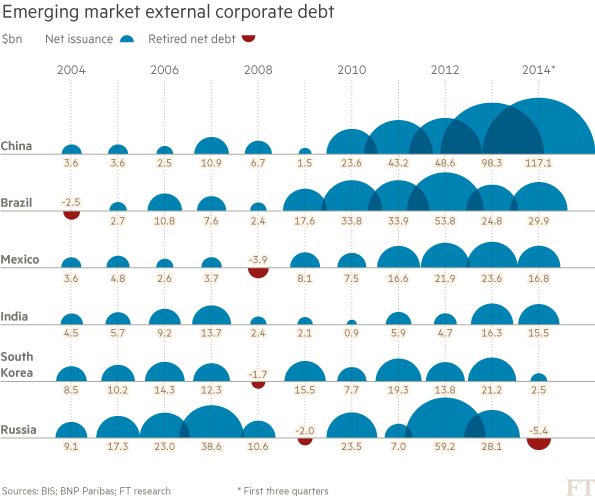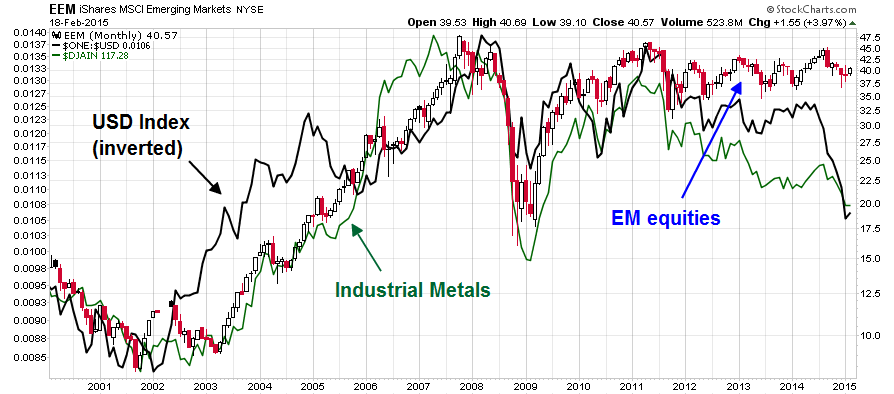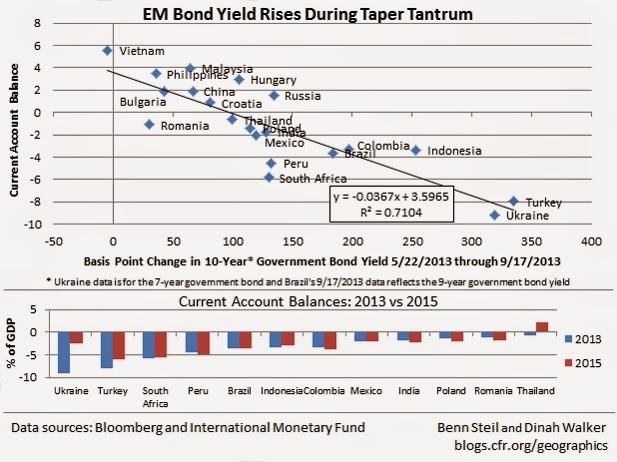The release of the latest FOMC minutes generated much reaction. I had been watching for their discussion of non-US risks and found their views rather disappointing. The Fed was primarily focused on first order effects of risks from Europe, China, Greece and so on:
In their discussion of the foreign economic outlook, participants noted that a number of developments over the intermeeting period had likely reduced the risks to U.S. growth. Accommodative policy actions announced by a number of foreign central banks had likely strengthened the outlook abroad. The decline in energy prices was also seen as potentially exerting a stronger-than-anticipated positive effect on growth in the domestic economy and abroad. However, the increase in the foreign exchange value of the dollar was expected to be a persistent source of restraint on U.S. net exports, and a few participants pointed to the risk that the dollar could appreciate further. In addition, the slowdown of growth in China was noted as a factor restraining economic expansion in a number of countries, and several continuing risks to the international economic outlook were cited, including global disinflationary pressure, tensions in the Middle East and Ukraine, and financial uncertainty in Greece.
The conclusion was that risks were not overly excessive:
Overall, the risks to the outlook for U.S. economic activity and the labor market were seen as nearly balanced.
Yeah, OK...
I believe that the FOMC may have missed a key tail-risk of the consequences of US monetary policy. Here is their discussion of tail-risk, or "potential risks to financial stability" in the FOMC minutes. Sure, liquidity risk in the bond market is something to keep an eye on, as bond mutual fund and ETF investors could all try to all head for the exits at the same time (emphasis added):
The staff provided its latest report on potential risks to financial stability. Relatively high levels of capital and liquidity in the banking sector, moderate levels of maturity transformation in the financial sector, and a relatively subdued pace of borrowing by the nonfinancial sector continued to be seen as important factors limiting the vulnerability of the financial system to adverse shocks. However, the staff report noted valuation pressures in some asset markets. Such pressures were most notable in corporate debt markets, despite some easing in recent months. In addition, valuation pressures appear to be building in the CRE sector, as indicated by rising prices and the easing in lending standards on CRE loans. Finally, the increased role of bond and loan mutual funds, in conjunction with other factors, may have increased the risk that liquidity pressures could emerge in related markets if investor appetite for such assets wanes. The effects on the largest banking firms of the sharp decline in oil prices and developments in foreign exchange markets appeared limited, although other institutions with more concentrated exposures could face strains if oil prices remain at current levels for a prolonged period.
There is something else that the Fed seems to have missed.
What about the $9 trillion in offshore USD loans?
Bloomberg featured a very different kind of risk when it asked about the $9 trillion in offshore USD paper sloshing around the global financial system (emphasis added):
When Group of 20 finance ministers this week urged the Federal Reserve to “minimize negative spillovers” from potential interest-rate increases, they omitted a key figure: $9 trillion.
That’s the amount owed in dollars by non-bank borrowers outside the U.S., up 50 percent since the financial crisis, according to the Bank for International Settlements. Should the Fed raise interest rates as anticipated this year for the first time since 2006, higher borrowing costs for companies and governments, along with a stronger greenback, may add risks to an already-weak global recovery.
The dollar debt is just one example of how the Fed’s tightening would ripple through the world economy. From the housing markets in Canada and Hong Kong to capital flows into and out of China and Turkey, the question isn’t whether there will be spillovers -- it’s how big they will be, and where they will hit the hardest.
There is no doubt that the Fed will tighten, it's just a question of when. With other major global central banks firmly in easing mode, rising US rates will put upward pressure on the USD in FX markets. The key question is how foreign borrowers of USD, which are mainly EM countries and companies, will handle the stress:
A study on dollar-denominated debt by the BIS in Basel, Switzerland, found that overseas borrowers increased issuance of dollar liabilities more in countries where interest rates were higher than U.S. yields. With American yields at historic lows for much of the last several years, the differentials provided a strong incentive to borrow in dollars instead of local currencies.
China accounts for the biggest share of borrowings, amounting to $1.1 trillion, while the stock of dollar credit in Brazil totals more than $300 billion, according to the BIS report.
As U.S. interest rates go up, it would become more expensive to borrow dollars. A stronger greenback means a company or government needs even more local currency to repay debt if it lacks revenues in dollars.
In a recent article, the FT warned about the explosion in EM corporate debt, much of which was issued by corporations based in EM resource-based economies, as well as China (emphasis added):
A decade ago, the market for EM hard currency corporate bonds hardly existed. Today, it is bigger than the US high-yield corporate bond market, an asset class familiar to investors for decades, and more than four times the size of Europe’s high-yield bond market.
What has driven such extraordinary growth? In just a few years before the global financial crisis of 2008-09, emerging markets won over the world’s investors. In 2001, Goldman Sachs (NYSE:GS) identified the Bric economies — Brazil, Russia, India and China — as the new engines of global growth. Chinese demand drove a commodity boom that helped billions of people rise out of poverty and into the consuming classes.
After the crisis, the developed world’s expansionary monetary policies kept the party going, pushing cheap credit to EM consumers and sending ever more foreign money into EM assets. Emerging companies, many able to tap overseas markets for the first time, embarked on a borrowing spree. Yield-hungry foreign investors were happy to help.
David Spegel, global head of EM sovereign and corporate bond strategy at BNP Paribas (PARIS:BNPP), has been following hard currency EM corporate bonds since 1994. His figures show that the value of such bonds in the market has grown from $107bn then to more than $2tn today.
But with Brazil’s economy imploding, China slowing and dark shadows over markets from Venezuela to Russia and Ukraine, some analysts worry that the party has gone on too long.
Stuart Oakley, global head of EM foreign exchange trading at Nomura in London, points to how easily things could go wrong. “It is entirely possible that we could see a default by a big, emerging market commodity exporting corporate,” he says.
“In that scenario you would get people redeeming money from big EM asset managers, bids for the bonds from banks would dry up, there would be sharp price drops on those and all associated assets and a sell-off across this or another asset class.”

As the chart shows, EM external corporate debt has skyrocketed over the years. What about the liquidity concerns voiced by FOMC staff over mass mutual fund redemptions, wouldn't an EM bond market rout be even worse?

With commodity prices in freefall, what happens next? Izabella Kaminska at FT Alphaville had some revealing analysis. First, she pointed to the BIS study:
Shifting to data for the end of 2013, only $2.3 trillion ($2.1 trillion) out of the $8.6 ($7.6 trillion) in dollar claims on non-banks (non-financials) outside the US were held in the US (Graph 3, middle two arrows). In other words, offshore holdings represent almost three-quarters of the dollar credit extended to non-financial borrowers outside the US.
Her key point is that all this USD liquidity is offshore and therefore outside the reach of Federal Reserve regulation. So much for all those ”macro-prudential policies” that the Fed is relying on to cushion the impact of the next financial crisis:
But the key point the authors were making, which continues to be ignored by the world and his dog, is that the primary source for most of the world’s external dollar debt has been non-US banks operating outside the US, which have trillions of dollars of deposits for swapping into other currencies for and non-US asset managers sitting on similarly large levels of dollar assets.
This, in their opinion, totally undermines the popular theory that the Fed’s large-scale asset purchases inject liquidity into banks in the US, which they in turn extend to offshore banks, which lend the dollars further.
This, de facto implies that the vast majority of the external dollar debt position is funded by an independent dollar float that sits separate to the US dollar system, but which depends on trade flows from the true US dollar system to be funded.
She concluded that the Fed's QE program created a multiplier effect on offshore USD assets and it is now at risk of reversal (my emphasis):
To us, that suggests the more QE the US did without issuing a commensurate amount of its own debt because of, you know, debt ceiling, the more it encouraged the external US dollar float to be relent multiple times (fractional reserve style) abroad before finally being soaked up by the sort of SWFs that would reinvest that float in US domestic assets.
But we’re now at a point where, unless all those external debtors have an organic way to keep dollars flowing into their coffers — i.e. without dependence on financing from non-US dollar pool sources — the value of all those loans, as well as the external US dollar pool itself, could quite abruptly and violent collapse in value.
In a different post, Kaminska highlighted a Citi research report which postulated a collapse in USD offshore liquidity because oil exporting countries lack the petrodollars to recycle back into the USD credit markets. (And this was written in November 2014, before the collapse in oil prices, emphasis added):
One somewhat novel theory is that sharply lower crude prices might have something to do with the change in the technicals. It seems plausible to us that lower crude prices have led to a slower rate of petrodollar accumulation by oil-exporting countries and less recycling of those funds back into global financial markets—amounting to a non-negligible retraction in liquidity.
There’s little doubt the petrodollar bid for fixed income securities has been tremendous during the last five years. The FX reserves of OPEC members have increased nearly 60% since 2009 to more than $1.3tn—a figure that would surpass $2tn if certain non-OPEC members, like Russia, were included. Likewise, sovereign wealth funds that are primarily funded by crude sales have increased nearly 80% over the same time period to more than $4tn (see figure). Taken together, the AUM of petrodollar investors has increased by $2.5tn in the space of 5 years, or roughly $500bn per year.
While the drop in oil prices amounts to a redistribution of wealth from oil producers to consumers, Citi believes that the net effect is not neutral when it comes to the USD credit markets:
While that’s certainly the case, what matters is how the savings from lower crude oil prices end up getting invested relative to the investments made by sovereign wealth funds and FX reserve managers. And on that score, we suspect that petrodollar investors generally make conservative investments that are inherently fixed income-friendly, while the savings from lower gasoline prices tend to grow the top line revenue of consumer-oriented companies and the margins of those companies with significant transportation costs. As such, forsaken petrodollars rarely find their way back into fixed income markets.
Vulnerable EM
The current environment leaves a number of EM economies highly vulnerable to the triple whammy of a strong USD, rising interest rates and worsening USD liquidity and falling export earnings because of lower commodity prices. The chart below shows the tight correlation the EM equities (iShares MSCI Emerging Markets ETF (ARCA:EEM)) have had with the USD and industrial metal prices. EEM is now experiencing a negative divergence with these indicators, which leaves this asset class vulnerable to more price weakness.

To be sure, not all EM economies are exposed the same way to falling commodity prices. Benn Steil and Dinah Walker at CFR analyzed the level of sensitivity of EM economies to US rate hikes, based on the Taper Tantrum episode:

They concluded:
As the bottom figure suggests, many of the same countries are likely to be in the firing line – in particular, Ukraine, Turkey, South Africa, Peru, Brazil, Indonesia, Colombia, Mexico, and India. Of these, only Ukraine has seen a significant improvement in its current account deficit, which has fallen from a whopping 9.2% to 2.5%. Poland and Romania have moderate (2%) but higher deficits, and could receive a larger jolt this time around. Only Thailand has moved into surplus, and looks likely to be spared.
In addition, I am concerned about the possible effects on China. The BIS study estimated total USD offshore loans to China, which includes government and corporate borrowers, to be $1.1 trillion - that`s not an insignificant amount.
So far, neither the EM bond markets nor equity markets have been spooked by the prospect of Fed tightness. Nevertheless, I was surprised by the tone of the FOMC minutes as the Fed does not appear to have considered this second-order effect tail-risk to the global financial system.
Disclosure: Cam Hui is a portfolio manager at Qwest Investment Fund Management Ltd. ("Qwest"). This article is prepared by Mr. Hui as an outside business activity. As such, Qwest does not review or approve materials presented herein. The opinions and any recommendations expressed in this blog are those of the author and do not reflect the opinions or recommendations of Qwest.
None of the information or opinions expressed in this blog constitutes a solicitation for the purchase or sale of any security or other instrument. Nothing in this article constitutes investment advice and any recommendations that may be contained herein have not been based upon a consideration of the investment objectives, financial situation or particular needs of any specific recipient. Any purchase or sale activity in any securities or other instrument should be based upon your own analysis and conclusions. Past performance is not indicative of future results. Either Qwest or Mr. Hui may hold or control long or short positions in the securities or instruments mentioned.
